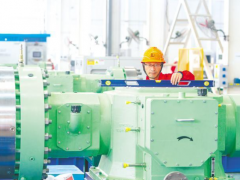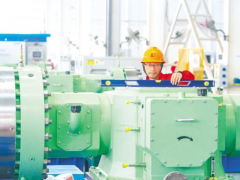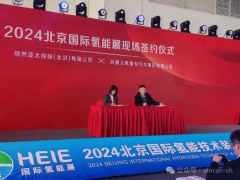据油气新闻网7月7日报道,根据国际可再生能源机构(IRENA)在其新的报告系列中表示,为了使氢贸易具有成本效益,生产和交易绿色氢的成本必须低于国内生产,以抵消更高的运输成本。
氢贸易可以促进更多样化和更有弹性的能源系统,使各国经济脱碳,造福于生产者和消费者。
“全球氢贸易以满足1.5℃的气候目标”表明未来的氢贸易可能具有重大意义。随着项目规模的进展和技术的成熟,贸易使人们能够开发出廉价的氢气。据报告称,全球四分之一的绿色氢需求可以通过管道和船舶进行国际贸易来满足。
随着可再生能源成本的下降和全球氢潜力超过全球能源需求的20倍,到2050年,全球四分之三的氢仍将在当地生产和使用。
这与当今石油市场的大宗国际交易相比是一个重大变化,但与天然气市场的三分之一是跨境交易类似。Irena表示,与今天的石油和天然气市场相比,氢市场和贸易路线可能更加多样化、地区性,利润也不那么丰厚。
Irena总干事Francesco La Camera表示,获得充足的可再生能源不足以赢得氢竞争,发展氢贸易也是必要的。
他指出,诚然,氢贸易可以为各国从脱碳工业到供应多样化和提高能源安全提供多种机会。今天的能源进口国也可以成为未来的出口国。
La Camera补充道,但政府必须做出重大努力,将贸易愿望变成现实。创新、政策支持和扩大规模可以带来必要的成本降低,并创造一个全球氢市场。能否实现贸易潜力将在很大程度上取决于各国的政策和投资重点,以及他们自己能源系统脱碳的能力。
Irena的《世界能源转型展望》认为,到2050年,氢将覆盖全球12%的能源需求,减少10%的二氧化碳排放。
然而,只有在生产氢气所需的电力与能源系统的电气化并举的情况下,氢气才能成为一个可行的气候解决方案,这使得更大程度上利用可再生能源成为转型的核心。如果成本下降,到2050年,每公斤1美元以下的绿色氢将满足世界能源需求的10倍。
据新的报告显示,到2050年,一半的氢将通过主要现有的、重新利用的天然气管道进行交易,这将大大降低运输成本。到2050年,成本约为每1000公里每公斤0.10美元,这将是3000公里以下最具成本效益的选择。
相比之下,通过新管道的运输成本将是原来的两倍。这仍低于以绿色氨的形式运输超过3000公里-5000公里,其占全球氢贸易的一半。根据分析,氨运输将成为洲际氢贸易的主导形式。
据Irena称,未来通过管道进行的贸易将集中在两个区域市场,分别是占全球85%的欧洲和占全球15%的拉丁美洲。欧洲的主要贸易伙伴将是北非和中东,而澳大利亚主要供应亚洲。
新的贸易市场将使能源参与者发挥不同的作用。2050年,一些最大的潜在管道氢出口国是智利、北非和西班牙,它们几乎占据了管道贸易市场的四分之三。像亚洲大国和美国这样的主要消费国能够在国内生产大部分氢。
其补充道,非洲、澳大利亚和北美占全球出口的四分之三。在进口方面,日本、韩国和欧盟预计将通过进口来满足它们的大部分氢气需求。
郝芬 译自 油气新闻网
原文如下:
A quarter of global hydrogen set for trading by 2050, says IRENA
To make the trade of hydrogen cost-effective, the costs of producing and trading green hydrogen must be lower than domestic production to offset higher transport cost, the International Renewable Energy Agency (IRENA) said in its new report series.
Hydrogen trade can contribute to a more diversified and resilient energy system, allowing countries to decarbonise their economies to the benefit of producers and consumers.
‘Global hydrogen trade to meet the 1.5°C climate goal’ finds that future hydrogen trade can be significant. Trade allows to tap into affordable hydrogen as scale of projects progresses and technology matures. One-quarter of the global green hydrogen demand could be satisfied with international trade through pipelines and ships, according to the reports.
With the costs of renewables falling and the global hydrogen potential exceeding global energy demand 20-fold times, three-quarters of the global hydrogen would still be produced and used locally in 2050.
This is a significant change from today’s oil market where the bulk is internationally traded, but it is similar to gas where one third is traded across borders. Hydrogen markets and trade routes are likely to be more diverse, regional and less lucrative than today’s oil and gas markets, sdtated Irena.
"Having access to abundant renewables will not be enough to win the hydrogen race, it’s also necessary to develop hydrogen trade," Irena’s Director-General Francesco La Camera said.
“It is true that hydrogen trade can offer multiple opportunities for countries from decarbonising industry to diversifying supplies and improving energy security. Today’s energy importers can also become the exporters of the future,” he noted.
“But governments must make significant efforts to turn trade aspirations into reality”, La Camera added. “A mix of innovation, policy support and scaling up can bring the necessary cost reduction and create a global hydrogen market. Whether trade potentials can be realised will strongly depend on countries’ policies and investment priorities and the ability to decarbonise their own energy systems,” he added.
Irena’s World Energy Transitions Outlook sees hydrogen covering 12 per cent of global energy demand and cutting 10 per cent of CO2 emissions by 2050.
Yet, hydrogen can only be a viable climate solution if the power needed to produce it comes in addition to the electrification of the energy system, placing an even greater uptake of renewable power at the heart of the transition. If costs come down, green hydrogen below $1 per kilogram (kg) would be available to meet ten times the world’s energy demand in 2050.
The new reports see half of the hydrogen in 2050 being traded through largely existing, repurposed gas pipelines drastically reducing the costs of transport. With costs of around USD 0.10/kg per 1 000 kilometres (km) in 2050, it would be the most cost-effective option for less than 3000 km distances.
By contrast, transportation through new pipelines would cost twice as much. This is still less than shipping it in the form of green ammonia over 3 000–5 000 km, the other half of global hydrogen trade. Ammonia shipping will become the dominant form of intercontinental hydrogen trade, according to the analysis.
According to Irena, this future pipeline-enabled trade would be concentrated in two regional markets namely Europe with the vast majority of 85 per cent of the hydrogen trade and Latin America with 15 per cent. Europe’s main trading partners would be North Africa and the Middle East while Australia could mainly supply Asia.
New trade markets would lead to different roles for energy players. Some of the largest potential exporters of hydrogen by pipeline in 2050 are Chile, North Africa and Spain, representing almost three-quarters of the pipeline trade market. Major consumers like big country in Asia and USA are able to produce most of their hydrogen domestically.
Africa, Australia and North America, account for three-quarters of the global exports. On the importing side, Japan, South Korea and the European Union are expected to satisfy a large share of their hydrogen demand through imports, it added.
免责声明:本网转载自其它媒体的文章及图片,目的在于弘扬石化精神,传递更多石化信息,宣传国家石化产业政策,展示国家石化产业形象,参与国际石化产业舆论竞争,提高国际石化产业话语权,并不代表本网赞同其观点和对其真实性负责,在此我们谨向原作者和原媒体致以崇高敬意。如果您认为本站文章及图片侵犯了您的版权,请与我们联系,我们将第一时间删除。







